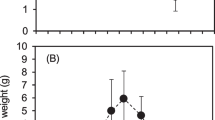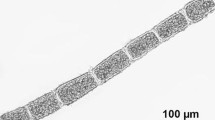Abstract.
The uptake of ammonium and subsequent movement of nitrogen between symbiotic dinoflagellates (zooxanthellae) and host tissue in the sea anemones Bartholomea annulata (Le Sueur) and Aiptasia pallida (Verrill) were studied in time course experiments using \({}^{15}{\rm NH}_4^ + \) in 1994. Although there was net uptake of ammonium during exposure to the tracer, there was significant, concurrent efflux, and the anemones continued to lose ammonium over 11 days in low-nutrient seawater. There was no clear evidence of translocation of nitrogen from the zooxanthellae to the host in either species. Host tissue in both species was capable of ammonium assimilation based on simultaneous appearance of 15N in host and zooxanthellae, as well as in aposymbiotic A. pallida and symbiont-free body column tissue of B. annulata. The amount of tracer in B. annulata tentacles from a single anemone was significant, with 66% of total 15N atoms present in the host at all times during exposure to \({}^{15}{\rm NH}_4^ + \) and during the subsequent 11-day chase period. The degree of labeling in the tentacles of B. annulata and symbiotic A. pallida was much greater than host tissue elsewhere in B. annulata or in aposymbiotic A. pallida, demonstrating a strong influence of the symbionts on host metabolism. Our data are consistent with the conservation paradigm that photosynthate from the zooxanthellae reduces the host catabolism of nitrogenous compounds for respiration so that there is little ammonium to be recycled. Although there was little support for nitrogen recycling in our studies, there is likely a continuum between the recycling and conservation paradigms that depends on the availability of photosynthate and hence the coupling between carbon and nitrogen cycles of the partners.
Similar content being viewed by others
Author information
Authors and Affiliations
Additional information
Electronic Publication
Rights and permissions
About this article
Cite this article
Lipschultz, .F., Cook, .C. Uptake and assimilation of 15N-ammonium by the symbiotic sea anemones Bartholomea annulata and Aiptasia pallida: conservation versus recycling of nitrogen. Marine Biology 140, 489–502 (2002). https://doi.org/10.1007/s00227-001-0717-1
Received:
Accepted:
Issue Date:
DOI: https://doi.org/10.1007/s00227-001-0717-1




